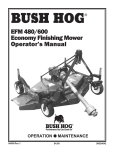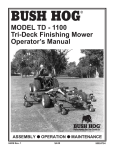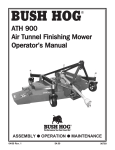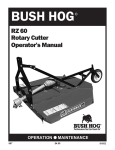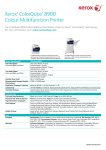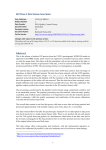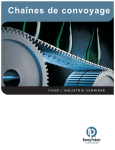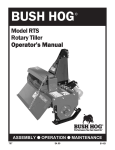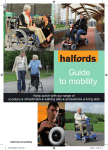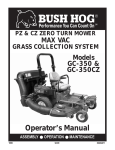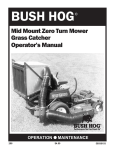Download Bush Hog Grass Catcher Operator`s manual
Transcript
BUSH HOG ® ESTATE ZERO TURN MOWER GRASS CATCHER Model GC-310 Operator’s Manual ASSEMBLY ● OPERATION ● MAINTENANCE 206 $4.00 50052079 CONGRATULATIONS! You have invested in the best implement of its type on the market today. The care you give your Bush Hog implement will greatly determine your satisfaction with its performance and its service life. We urge a careful study of this manual to provide you with a thorough understanding of your new implement before operating, as well as suggestions for operation and maintenance. If your manual should become lost or destroyed, Bush Hog will be glad to provide you with a new copy. Order from Bush Hog, P. O. Box 1039, Selma, Alabama 36702-1039. Most of our manuals can also be downloaded from our website at www.bushhog.com. As an authorized Bush Hog dealer, we stock genuine Bush Hog parts which are manufactured with the same precision and skill as our original equipment. Our trained service personnel are well informed on methods required to service Bush Hog equipment, and are ready and able to help you. Should you require additional information or assistance, please contact us. YOUR AUTHORIZED BUSH HOG DEALER BECAUSE BUSH HOG MAINTAINS AN ONGOING PROGRAM OF PRODUCT IMPROVEMENT, WE RESERVE THE RIGHT TO MAKE IMPROVEMENTS IN DESIGN OR CHANGES IN SPECIFICATIONS WITHOUT INCURRING ANY OBLIGATION TO INSTALL THEM ON UNITS PREVIOUSLY SOLD. BECAUSE OF THE POSSIBILITY THAT SOME PHOTOGRAPHS IN THIS MANUAL WERE TAKEN OF PROTOTYPE MODELS, PRODUCTION MODELS MAY VARY IN SOME DETAIL. IN ADDITION, SOME PHOTOGRAPHS MAY SHOW SHIELDS REMOVED FOR PURPOSES OF CLARITY. NEVER OPERATE THIS IMPLEMENT WITHOUT ALL SHIELDS IN PLACE. ESTATE ZERO TURN MOWER GRASS CATCHER TABLE OF CONTENTS SECTION SECTION PAGE Warranty . . . . . . . . . . . . . . . . . . . . . . . . . . . . . 2 2-9 Attachment of The Upper Hose . . . . . . . . . . 8 2-10 Attachment Of The Upper Hose To. . . . . . . . 8 The Lower Cone 2-11 Attachment Of The Lower Hose To . . . . . . 8 The Boot 2-12 Front Weight Assembly . . . . . . . . . . . . . . . 8 2-13 Installation/Removal Of Collection Bags . . 8 Federal Laws and Regulations . . . . . . . . . . . . 3 Safety Alert Symbols. . . . . . . . . . . . . . . . . . . . 4 I INTRODUCTION AND DESCRIPTION . . . . . 5 1-1 Introduction . . . . . . . . . . . . . . . . . . . . . . . . 5 1-2 Description . . . . . . . . . . . . . . . . . . . . . . . . 5 II PREPARATION FOR USE . . . . . . . . . . . . . . . 5 2-1 Modification Of ZT. . . . . . . . . . . . . . . . . . . 5 2-2 Attaching Frame Mount Brackets . . . . . . . 6 2-3 Belt Installation . . . . . . . . . . . . . . . . . . . . . 6 2-4 Cam Assembly Adjustment. . . . . . . . . . . . 7 2-5 Attachemnt Of Upper Frame. . . . . . . . . . . 7 Assembly To The Lower Frame 2-6 Attachment Of Top Assembly To The. . . . 7 Upper Frame Assembly 2-7 Attachment Of The Boot To . . . . . . . . . . . 7 The Mower Deck 2-8 Adjustment Of The Lengths Of Hoses . . . 8 PAGE III OPERATING INSTRUCTIONS . . . . . . . . . . . . 10 3-1 General Safety . . . . . . . . . . . . . . . . . . . . . . 10 3-2 Operation & Tips On Mowing . . . . . . . . . . . 10 3-3 Disengagement Of The Blower . . . . . . . . . 10 IV MAINTENANCE . . . . . . . . . . . . . . . . . . . . . . . . 10 4-1 Maintenance Checklist . . . . . . . . . . . . . . . . . . . 10 4-2 Lubrication . . . . . . . . . . . . . . . . . . . . . . . . . . . . . 11 Safety Decals . . . . . . . . . . . . . . . . . . . . . . . . . . . 12 Torque Specifications . . . . . . . . . . . . . . . . . . . . 13 RETAIL CUSTOMER’S RESPONSIBILITY UNDER THE BUSH HOG WARRANTY It is the Retail Customer and/or Operator’s responsibility to read the Operator’s Manual, to operate, lubricate, maintain and store the product in accordance with all instructions and safety procedures. Failure of the operator to read the Operator’s Manual is a misuse of this equipment. It is the Retail Customer and/or Operator’s responsibility to inspect the product and to have any part(s) repaired or replaced when continued operation would cause damage or excessive wear to other parts or cause a safety hazard. It is the Retail Customer’s responsibility to deliver the product to the authorized Bush Hog Dealer, from whom he purchased it, for service or replacement of defective parts which are covered by warranty. Repairs to be submitted for warranty consideration must be made within forty-five (45) days of failure. It is the Retail Customer’s responsibility for any cost incurred by the Dealer for traveling to or hauling of the product for the purpose of performing a warranty obligation or inspection. 1 BUSH HOG® LIMITED WARRANTY ✯✯✯✯✯✯✯✯✯✯✯✯✯✯✯✯✯✯✯✯✯✯✯✯✯✯✯✯✯✯✯ Bush Hog warrants to the original purchaser of any new Bush Hog equipment, purchased from an authorized Bush Hog dealer, that the equipment be free from defects in material and workmanship for a period of one (1) year for non-commercial, state, and municipalities’ use and ninety (90) days for commercial use from date of retail sale. The obligation of Bush Hog to the purchaser under this warranty is limited to the repair or replacement of defective parts. Replacement or repair parts installed in the equipment covered by this limited warranty are warranted for ninety (90) days from the date of purchase of such part or to the expiration of the applicable new equipment warranty period, whichever occurs later. Warranted parts shall be provided at no cost to the user at an authorized Bush Hog dealer during regular working hours. Bush Hog reserves the right to inspect any equipment or parts which are claimed to have been defective in material or workmanship. DISCLAIMER OF IMPLIED WARRANTIES & CONSEQUENTIAL DAMAGES Bush Hog’s obligation under this limited warranty, to the extent allowed by law, is in lieu of all warranties, implied or expressed, INCLUDING IMPLIED WARRANTIES OF MERCHANTABILITY AND FITNESS FOR A PARTICULAR PURPOSE and any liability for incidental and consequential damages with respect to the sale or use of the items warranted. Such incidental and consequential damages shall include but not be limited to: transportation charges other than normal freight charges; cost of installation other than cost approved by Bush Hog; duty; taxes; charges for normal service or adjustment; loss of crops or any other loss of income; rental of substitute equipment, expenses due to loss, damage, detention or delay in the delivery of equipment or parts resulting from acts beyond the control of Bush Hog. THIS LIMITED WARRANTY SHALL NOT APPLY: 1. To vendor items which carry their own warranties, such as engines, tires, and tubes. 2. If the unit has been subjected to misapplication, abuse, misuse, negligence, fire or other accident. 3. If parts not made or supplied by Bush Hog have been used in connection with the unit, if, in the sole judgement of Bush Hog such use affects its performance, stability or reliability. 4. If the unit has been altered or repaired outside of an authorized Bush Hog dealership in a manner which, in the sole judgement of Bush Hog, affects its performance, stability or reliability. 5. To normal maintenance service and normal replacement items such as gearbox lubricant, hydraulic fluid, worn blades, or to normal deterioration of such things as belts and exterior finish due to use or exposure. 6. To expendable or wear items such as teeth, chains, sprockets, belts, springs and any other items that in the company’s sole judgement is a wear item. NO EMPLOYEE OR REPRESENTATIVE OF BUSH HOG IS AUTHORIZED TO CHANGE THIS LIMITED WARRANTY IN ANY WAY OR GRANT ANY OTHER WARRANTY UNLESS SUCH CHANGE IS MADE IN WRITING AND SIGNED BY BUSH HOG’S SERVICE MANAGER, POST OFFICE BOX 1039, SELMA, ALABAMA 36702-1039. ✯✯✯✯✯✯✯✯✯✯✯✯✯✯✯✯✯✯✯✯✯✯✯✯✯✯✯✯✯✯✯ Record the model number, serial number and date purchased. This information will be helpful to your dealer if parts or service are required. MODEL NUMBER SERIAL NUMBER MAKE CERTAIN THE WARRANTY REGISTRATION CARD HAS BEEN FILED WITH BUSH HOG/ SELMA, ALABAMA DATE OF RETAIL SALE 2 IMPORTANT FEDERAL LAWS AND REGULATIONS* CONCERNING EMPLOYERS, EMPLOYEES AND OPERATIONS. *(This section is intended to explain in broad terms the concept and effect of the following federal laws and regulations. It is not intended as a legal interpretation of the laws and should not be considered as such). U.S. Public Law 91-596 (The Williams-Steiger Occupational and Health Act of 1970) OSHA This Act Seeks: “...to assure so far as possible every working man and woman in the nation safe and healthful working conditions and to preserve our human resources...” DUTIES Sec. 5 (a) Each employer— (1) shall furnish to each of his employees employment and a place of employment which are free from recognized hazards that are causing or are likely to cause death or serious physical harm to his employees; (2) shall comply with occupational safety and health standards promulgated under this Act. (b) Each employee shall comply with occupational safety and health standards and all rules, regulations and orders issued pursuant to this Act which are applicable to his own actions and conduct. OSHA Regulations Current OSHA regulations state in part: “At the time of initial assignment and at least annually thereafter, the employer shall instruct every employee in the safe operation and servicing of all equipment with which the employee is, or will be involved.” These will include (but are not limited to) instructions to: Keep all guards in place when the machine is in operation; Permit no riders on equipment; Stop engine, disconnect the power source, and wait for all machine movement to stop before servicing, adjusting, cleaning or unclogging the equipment, except where the machine must be running to be properly serviced or maintained, in which case the employer shall instruct employees as to all steps and procedures which are necessary to safely service or maintain the equipment. Make sure everyone is clear of machinery before starting the engine, engaging power, or operating the machine. EMPLOYEE TRACTOR OPERATING INSTRUCTIONS: 1. Securely fasten your seat belt if the tractor has a ROPS. 5. Watch where you are going, especially at row ends, on roads, and around trees. 2. Where possible, avoid operating the tractor near ditches, embankments, and holes. 6. Do not permit others to ride. 7. Operate the tractor smoothly - no jerky turns, starts, or stops. 3. Reduce speed when turning, crossing slopes, and on rough, slick, or muddy surfaces. 8. Hitch only to the drawbar and hitch points recommended by tractor manufacturers. 4. Stay off slopes too steep for safe operation. 9. When tractor is stopped, set brakes securely and use park lock if available. Child Labor Under 16 Years Old Some regulations specify that no one under the age of 16 may operate power machinery. It is your responsibility to know what these regulations are in your own area or situation. (Refer to U.S. Dept. of Labor, Employment Standard Administration, Wage & Home Division, Child Labor Bulletin #102.) 3 Safety Alert Symbol This Safety Alert Symbol means: “ATTENTION! BECOME ALERT! YOUR SAFETY IS INVOLVED!” This symbol is used to call attention to safety precautions that should be followed by the operator to avoid accidents. When you see this symbol, carefully read the message that follows and heed its advice. Failure to comply with safety precautions could result in death or serious bodily injury. Safety Signs Signal Words The signal words DANGER, WARNING, AND CAUTION are used on the equipment safety signs. These words are intended to alert the viewer to the existence and the degree of hazard seriousness. This signal word indicates a potentially hazardous situation which, if not avoided, will result in death or serious injury. White letters on RED This signal word indicates a potentially hazardous situation which, if not avoided, could result in death or serious injury It may also be used to alert against unsafe practices. Black letters on ORANGE This signal word indicates a potentially hazardous situation exist which, if not avoided, may result in minor or moderate injury. It may also be used to alert against unsafe practices. Black letters on YELLOW 4 SECTION I INTRODUCTION AND DESCRIPTION Figure 1 Figure 2 Complete Machine In Shipping Crate Crate and Boxes Opened For Parts Removal 1-1 Introduction We are pleased to have you as a return Bush Hog customer. Your GC-310 has been designed to give you a low maintenance, simple, and effective way to collect the grass clippings from your Bush Hog Estate ZT mower. This manual is provided to give you the necessary instructions to properly mount and operate the GC-310 on your ZT mower. Please read this manual thoroughly. Understand what each control is for and how to use it. Observe all safety decal precautions on the machine and noted throughout the manual. SECTION II PREPARATION FOR USE 2-1 ZT Modification Of Zero Turn Carefully remove wrapping from around shipping crate and open boxes. Remove and sort all parts for easy identification. NOTE: Before each step of assembly it will help to study the exploded drawings on pages7, 8, and 9. Note: all references made to right, left, front, rear, top or bottom are as viewed from the normal operator's position on the ZT mower. From the underside of the ZT engine remove the bolt and bushing from the electric clutch assembly. Replace these parts with the pulley and 7/16”-20 x 3-1/4” bolt that will power the grass catcher blower. Note that the center of the hub that is extended should be upward toward the engine. (Figure 3) Torque the bolt to 55 ft./lbs. Note: All work must be performed with the engine off and the parking brake locked. 1-2 Description The GC-310 Grass Catcher, Figure 1, is designed for turf maintenance where there is a need to collect the grass clippings as the ZT mower cuts the turf. It is also good for picking up leaves and twigs in preseason and post-season clean-up. Figure 3 Electric Clutch Assy. Grass Catcher Pulley The blower, mounted on the right side of the unit, uses a belt and gearbox system from the engine PTO shaft. Drive train protection comes through belt slippage. The blower draws grass clippings from the discharge area of the cutter deck up to the collection bags mounted over the rear portion of the ZT frame. The operator can engage the blower with a push of the over-center linkage on the right side of the unit. Once the bags are full of clippings, the top of the unit can be pivoted up and each of the three bags can be removed individually for emptying. 7/16”-20 x 3-1/4” Bolt 5 deck on your particualr ZT. Models with a 44” deck use the front mounting holes and models with a 52” deck use the rear holes. 2-2 Attaching Frame Mount Brackets To mount the frame mount brackets which support the bagger unit, you must first remove the existing rear bumper. Mount the brackets to the ZT frame as shown in Figure 4 below using 3/8”-16 x 1” bolts and 3/8” Nyloc nuts. NOTE: The front two bolt holes on 2-3 Belt Installation The gear box shield must first be removed to allow access to the bolts that secure the gear box. each side in the ZT frame must be enlarged by drilling with a 3/8” drill bit before using the new bolts. Figure 4 3/8” Bolts Loosen the two bolts that secure the gear box assembly to the PTO mount plate. (Figure 6) Loosen the adjustment bolt until the gear box assembly is at its far left adjustment (the gear box is moved towards the mower’s engine pully). Install the Kevlar cord belt from the engine pulley to the lower gear box pulley. To tension the drive belt, turn the adjustment bolt clockwise until there is 1” of deflection, with 10-11 lbs. of pressure between the engine pulley and the gear box pulley. Once the correct tension on the belt is achieved, tighten the (2) bolts that secure the gear box assembly and re-attach the shield. (Figures 6 and 7) Left Frame Mount Brackets Figure 6 Gear Box Attachment Bolts Are Under The Shield Bolt Location For 44” Deck Assemble right frame bracket to opposite side of the ZT frame as shown in Figure 5. Figure 5 Right Frame Mount Bracket Belt Tension Adjustment Bolt Blower Figure 7 Engine Pulley PTO Assembly Fasten the PTO assembly to the mount bracket as shown using 5/16 x 1” bolts and nylock nuts. IMPORTANT: Note that the lower frame assembly must be mounted at the same time utilizing the rear bolts. Also note that the lower frame must be located dependent on the size of the 6 Gear Box Shield Bolts 2-6 Attachment Of Top Assembly To The Upper Frame Assembly 2-4 Cam Assembly Adjustment The cam assembly, which controls the blower belt tension, comes from the factory pre-adjusted. If the belt is too tight, or becomes too loose, remove the hair pin clip from the belt tension rod and pull the “L” end of the rod out of its hole in the cam assembly . The tension rod may then be screwed out to tighten the belt or screwed in to loosen the belt. Replace the “L” end into the top hole in the cam and replace the hair pin clip. Adjust the cam stop bolt to allow the cam to rotate slightly over center when the blower is disengaged. (Figure 8) Align the pivot brackets of the top assembly to the pivot points on either side of the upper frame asssembly. Place a fender washer between each pivot point and fasten each side by using a 5/16” 18 x 3/4” bolt and nyloc nut. When fastening leave the nut slightly loose so that the top can pivot freely. (Figure 10) Figure 10 Top Assembly Locates Here Nyloc Nut Fender Washer Figure 8 Belt Tension Rod Cam Stop Bolt Is Below The Cam Assembly 5/16” - 18 x 3/4” Bolt 2-7 Attachment Of The Boot To The Mower Deck Remove the mower’s discharge chute from the cutter deck. The boot rod will replace the cap screws and create a mounting surface for the deck boot. Slide the boot rod through the lugs on the cutter deck and fasten into place with a hair pin clip as shown in Figure 11. 2-5 Attachment Of Upper Frame Assembly To The Lower Frame Attach the boot plate to the boot using 3/8 x 1” carriage bolts inserted from the inside of the boot. This will prevent grass from building up on the bolts. Use 3/8” serated, flanged lock nuts on the bolts, but do not tighten at this time. With the rod in place, slide the boot plate tabs under the rod. Allow the boot to rotate down and rest against the cutter deck opening. Adjust the boot location to cover the deck opening and tighten the lock nuts. (Figure 11) NOTE: During this step it is suggested that two people install the Top Frame to the Lower Frame Using two people to raise the top frame, lift the top frame above the lower frame making sure the bag frames are located away from the engine a shown in Figure 9. Slide the top frame vertical tube into the lower frame vertical tube aligning the holes. Insert the 1/2’ X 2-1/4” clevis pin through the holes and fasten with a hair pin clip. Figure 9 Top Frame Figure 11 Clevis Pin Lower Frame Boot Lower Hose Boot Plate 7 Hair Pin Clip Rod 2-8 Adjustment Of The Lengths Of Hoses 2-12 Front Weight Assembly The hoses in steps 2-9 and 2-10 must be cut to fit your machine. Follow the steps and do not cut the hoses until you have tried them on your particular machine. Remember that the hoses must be long enough to allow for enough clamping surface between the inlet, blower assembly and the deck boot. Attach each front weight bracket to the front cross member of the ZT frame as shown in Figure13. Note the positions of the left and right brackets. Fasten with two 3/8 x 3” bolts and flanged locknuts on each side. When installing the 100 lb. weight you should have another person help position the weight onto a floor jack. Using a floor jack will make installing the weight much easier. Lift the weight up to the weight brackets. Fasten the weight to the weight brackets by using a 1/2” 13 x 4-1/2” U-bolt and two flanged locknuts per bracket. Once the weight is secure, tighten all nuts. Be sure weight is centered in reference to the U-bolts. (Figure 13) 2-9 Attachment Of The Upper Hose Fasten the inlet to the plastic top by sliding the inlet from the inside of the top to the outside and snap into place. Slide a 5” - 6” upper hose clamp onto both ends of the 6” upper hose, then slide one end of the hose onto the inlet. Make sure there is about a 2” overlap between the hose end and the container inlet. Proceed to slide the opposite end of the hose onto the outlet of the blower assembly as shown in Figure 12. Make sure both ends of the hose are clearly attached to the inlet and the blower assembly inlet. Tighten the hose clamps. Figure 13 U-Bolts Front Weight Figure 12 Inlet Hose Clamp 6” Upper Hose 3/8 x 3” Flanged Locknuts 2-13 Installation/Removal Of Collection Bags To install the bag onto the ring, first install ring end caps onto both ends of the ring. Place the seam openings of the bag onto the bag ring openings and slide the bag around the ring until the slot bracket in the bag ring is protruding through the opening in the bag. Do this for each of the three bags. (Figure 14) Blower Outlet Blower Cone 8” Lower Hose Boot 2-10 Attachment Of The Lower Hose To The Blower Cone Figure 14 Bag Installation Fasten the blower cone to the blower housing by using two 5/16” - 18 x 2-1/2” bolts and jam nuts. Slide a 7”-8” hose clamp over each end of the lower hose, then proceed to slide the lower hose onto the blower cone. Tighten the hose clamps. (Figure 12) Bag Ring Slot Bracket 2-11 Attachment Of The Lower Hose To The Boot Take the unattached end of the lower hose and slide it over the circular end of the boot. Use the lower hose clamp to secure the hose to the boot. (Figure 12) Tip: Before securing the clamp, rotate the hose counter-clockwise (away from yourself) approximately 1” to aid in retaining boot to mower deck. Bag Ring End Caps (Under Fabric) Cloth Bag 8 Install the completed assemblies onto the support frame and close the plastic top. Fasten both draw latches to hold the plastic top closed. (Figures 15 & 16) Figure 15 One Bag Removed To empty the bag, remove the bag ring by lifting and sliding rearward. Grasp the loop on the bottom of the bag, turn it upside down and empty the collected debris. Repeat for the other bags. Reinstall all bags and line with plastic bags if desired, close the plastic top and reattach the draw latches. Plastic lawn and leaf bags, 33 galon size, may be used inside the cloth bags. Be sure to leave enough plastic bag hanging over the frame so the plastic bag can be twist tied before emptying. Plastic Top Figure 16 Inlet Draw Latches Upper Frame Assembly Bags With Bag Rings Installed Frame Mount Brackets Lower Frame 52” Deck, 44” Deck NOTE: Hole Locations For 52” Deck or 44” Deck 9 SECTION III OPERATING INSTRUCTIONS WARNING: To determine when the collection bags are full, follow the following steps: 3-1 General Safety Only qualified people familiar with this operator’s manual and the mower’s operator’s manual should operate this machine. A. B. C. D. E. Stop the forward movement of the mower. Disengage the mower deck. Disengage the blower. Engage the parking brake. Once the parking brake has been engaged, and only then, walk behind the mower and check the collection bags by lifting the plastic top.The load in the bags should not exceed the height of the installed bags. F. To release bags from the frame, lift the bag ring from the tab on the bagger frame, slide the bag out and turn the bag over to deposit the clippings. G. Follow steps on page 14 to re-attach the bags back to the bagger. 3-2 Operation And Tips On Mowing A. Perform BEFORE EACH USE maintenance list in paragraph 4-1. B. Start mower. C. While seated in the operator’s seat, rotate the engagement handle of the collection system away from the mower. Continue to rotate the handle until it stops in an over center position. With the blower engaged, you can proceed to operate the control levers of the mower. D. With the mower at high speed, engage the mower deck. NOTE: Do not allow collection bags to become over filled as potential damage may occur to your equipment. Also, be sure to clean the hood screen as needed. NOTE: If the collection system does not appear to be collection the grass clippings, disengage the deck and blower, then engage the parking brake and turn the engine off. proceed to Section 3-3 and review Section 2-6 in this manual. SECTION IV MAINTENANCE To obtain the maximum effectiveness from your collection system the tips listed below should be followed: * * * * * * 4-1 Maintenance Checklist Before each use: 1. Check blades and spindles to be sure that no foreign objects, such as wire or steel strapping bands, are wrapped around them. 2. Inspect blades for wear. Replace if necessary. If it is necessary to sharpen blades, remove the blades from the spindles before sharpening. DO NOT sharpen blades while still attached to the mower. 3. Make sure all shields are in place and in good condition. Repair or replace any missing or damaged shields. 4. Perform lubrication per paragraph 4-2. 5. Listen for abnormal sounds, which might indicate loose parts, damaged bearings, or other damage. Correct any deficiency before continuing operation. 6. With the engine off, engage the blower assembly. Check the belt tension and inspect the pulley belt for cracks or tears. 7. Check for wear or deterioration of the upper or lower hoses. If there are any portions of the hose that have been torn or worn through, replace with genuine BUSH HOG parts. Watch your speed - Normal conditions will allow a speed of up to approximately 5 mph, but thick, heavy damp conditions will require reduced ground speed. Mow with sharp blades - A sharp blade cuts cleaner. Wet grass and leaves will decrease effectiveness and will increase horsepower requirements. Mow at higher cutting heights - Remove and mulch no more than 2” of grass length with each mowing. (Experts recommend not cutting off more than 1/3 of the grass blade length at any given time.) Mow twice, at different height settings, (high, then low), if grass is extra tall. Remember that horsepower requirements will vary with the mowing conditions such as type and height of turf grass, moisture content, amount of leaves, whether the terrain is flat or hilly, etc. 3-3 Disengagement Of The Blower After Each Use: A. To disengage the blower, rotate the engagement handle towards the mower. 1. 10 Clean all debris from machine especially from the container, underneath the belt shields and off of safety decals. Replace any missing or illegible decals. 2. 3. Inspect the unit for worn or damaged components. Repair or replace before next use. Any replacement component installed during repair shall include the component’s current safety decal specified by the manufacturers to be affixed to the component. Check belt for proper tension. Parts And Service Information Bush Hog collection system owners should record the name and telephone number of their dealer. Your dealer will be happy to supply replacement parts, accessories and do any service or repairs to your collection system. If for any reason your dealer is unable to service your collection system or supply replacement parts, contact Bush Hog and include the following information from the serial number plate: 4-2 Lubrication NOTE: Use only white lithium base grease for lubrication of the shaft on the blower assembly. 1. 2. 3. Model Number_______________ Serial Number_______________ On the initial use: Grease the fitting on the blower shaft. Every 25 hours of use: Re-grease the grease fitting. Every 200 hours of use: Check oil levels in gear box. Oil in gear box should cover the gears. If not, fill using an EP90 weight oil. 6 oz. will fill the gear box from empty. 11 SAFETY DECALS To promote safe operation, Bush Hog supplies safety decals on all products manufactured. Because damage can occur to safety decals either through shipment, use or reconditioning, Bush Hog will, upon request, provide safety decals for any of our products in the field at no charge. Contact your authorized Bush Hog dealer for more information. 50031304 50031301 50031302 50031303 50052129 50052916 50052915 12 TORQUE SPECIFICATIONS Proper toque for American fasteners used on Bush Hog equipment. Recommended Torque in Foot Pounds (Newton Meters).* AMERICAN Bolt Head Markings SAE Grade 2 (No Dashes) SAE Grade 5 (3 Dashes) ” lt Bo ter “B e m Dia Wrench Size “A” SAE Grade 8 (6 Dashes) METRIC Wrench Size “A” WRENCH SIZE (IN.) “A” BOLT DIAMETER (IN.) “B” AND THREAD SIZE SAE GRADE 2 SAE GRADE 5 SAE GRADE 8 7/16 1/4 - 2O UNC 6 (7) 8 (11) 12 (16) 7/16 1/4 - 28 UNF 6 (8) 10 (13) 14 (18) 1/2 5/16 - 18 UNC 11 (15) 17 (23) 25 (33) 1/2 5/16 - 24 UNF 13 (17) 19 (26) 27 (37) 9/16 3/8 - 16 UNC 20 (27) 31 (42) 44 (60) 9/16 3/8 - 24 UNF 23 (31) 35 (47) 49 (66) 5/8 7/16 - 14 UNC 32 (43) 49 (66) 70 (95) 5/8 7/16 - 20 UNF 36 (49) 55 (75) 78 (106) 3/4 1/2 - 13 UNC 49 (66) 76 (103) 106 (144) 3/4 1/2 - 20 UNF 55 (75) 85 (115) 120 (163) 7/8 9/16 - 12 UNC 70 (95) 109 (148) 153 (207) 7/8 9/16 - 18 UNF 79 (107) 122 (165) 172 (233) 15/16 5/8 - 11 UNC 97 (131) 150 (203) 212 (287) 15/16 5/8 - 18 UNF 110 (149) 170 (230) 240 (325) 1-1/8 3/4 - 10 UNC 144 (195) 266 (360) 376 (509) 1-1/8 3/4 - 16 UNF 192 (260) 297 (402) 420 (569) 1-5/16 7/8 - 9 UNC 166 (225) 430 (583) 606 (821) 1-5/16 7/8 - 14 UNF 184 (249) 474 (642) 668 (905) 1-1/2 1 - 8 UNC 250 (339) 644 (873) 909 (1232) 1-1/2 1 - 12 UNF 274 (371) 705 (955) 995 (1348) 1-1/2 1 - 14 UNF 280 (379) 721 (977) 1019 (1381) 1-11/16 1-1/8 - 7 UNC 354 (480) 795 (1077) 1288(1745) 1-11/16 1-1/8 - 12 UNF 397 (538) 890 (1206) 1444 (1957) 1-7/8 1-1/4 - 7 UNC 500 (678) 1120 (1518) 1817 (2462) 1-7/8 1-1/4 - 12 UNF 553 (749) 1241 (1682) 2013 (2728) 2-1/16 1-3/8 - 6 UNC 655 (887) 1470 (1992) 2382 (3228) 2-1/16 1-3/8 - 12 UNF 746 (1011) 1672 (2266) 2712 (3675) 2-1/4 1-1/2 - 6 UNC 870 (1179) 1950 (2642) 3161 (4283) 2-1/4 1-1/2 - 12 UNF 979 (1327) 2194 (2973) 3557 (4820) ” lt Bo ter “B e m Dia 8.8 Numbers appearing on bolt heads indicate ASTM class. *Use 75% of the specified torque value for plated fasteners. Use 85% of the specified torque values for lubricated fasteners. Proper torque for metric fasteners used on Bush Hog equipment. Recommended torque in foot pounds (newton Meters).* WRENCH SIZE (mm) “A” BOLT DIA. (mm) “B” ASTM 4.6 8 5 1.8 (2.4) 5.1 (6.9) 6.5 (8.8) 10 6 3 (4) 8.7 (12) 11.1 (15) ASTM 8.8 ASTM 9.8 ASTM 10.9 13 8 7.3 (10) 21.1 (29) 27 (37) 16 10 14.5 (20) 42 (57) 53 (72) 18 12 25 (34) 74 (100) 73 (99) 93 (126) 21 14 40 (54) 118 (160) 116 (157) 148 (201) 24 16 62 (84) 167 (226) 181 (245) 230 (312) 30 20 122 (165) 325 (440) 33 22 36 24 41 27 46 30 13 449 (608) 443 (600) 611 (828) 211 (286) 563 (763) 778 (1054) 821 (1112) 1138 (1542) 418 (566) 1119 (1516) 1547 (2096) ® BUSH HOG , L.L.C. P.O. Box 1039 ● Selma, AL 36702-1039 Telephone (334) 874-2700 ● www.bushhog.com
















